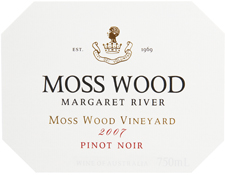Moss Wood 2007 Pinot Noir

Wine Facts
| Harvested: | 3/2/2007 |
| Bottled: | 2/11/2008 |
| Released: | 24/9/2009 |
| Yield: | 5.55 t/ha |
| Baume: | 13.20 |
| Alcohol: | 13.50% |
| Vintage Rating: | 9/10 |
SOLD OUT
Tasting Notes
Colour and condition: Deep ruby hue; bright condition. Nose: A rich, concentrated nose. The fruit aromas are complex combination of strawberries, cherries, beetroot and quince jelly, combined with cinnamon and barbecue spices. In the background are light fragrances of charry, toasty oak. Palate: The palate is an interesting combination of cherry-like dark fruits and plums, mixed with strawberry jam and charry, spicy oak. The mouthfeel is generous with full body and soft, round tannins.
Vintage Notes
In 2007 we had our earliest vintage on record. The Pinot Noir was 19 days earlier than its average harvest date of 23rd February. The curious thing is that the length of the season, measured as days elapsed between flowering and harvest suggest the season was cooler than these dates suggest. The “D4” clone took 93 days to ripen, only 4 less than its average of 97 days. The “D5” clone took 99 days, only one less than its average of 100. Unfortunately we can’t provide any temperature information because our weather station wasn’t working through this period. However, given the grape flavours all the varieties were able to retain and the quality of the resulting wines, we can assume things didn’t get excessively hot. The exception, of course, was Australia Day, when the overnight minimum hovered around the low 20’s. Not very comfortable for sleeping! The yields were moderate, with the vineyard production 5.55 tonnes per hectare, slightly below the long term average of 6.42. However, since the 2002 vintage, we have used aggressive crop thinning to try and maintain a ceiling of 5 tonnes per hectare, so we exceeded that ever so slightly. For interest sake and to give a pat on the back to clever viticulturists, the average yield on the Pinot Noir vineyard since 2002 is 4.89 tonnes per hectare. Overall, the season was very pleasing, if somewhat busy at the end when January’s hot finish brought the fruit to ripeness fairly rapidly and we had to get things off as quickly as possible. There were no problems with disease and we managed to control the birds using nets, although they had done some damage in the Old Block and which needed hand sorting.
Production Notes
Once in the winery the fruit was destemmed into small, open fermenters and the juice was pumped over and chilled down to 5C. The cold soaking continued for 3 days and then each batch was inoculated with pure yeast culture. Fermentation was allowed to proceed at warm temperatures, with the maximum set at 32C and each tank was hand plunged up to 4 times per day. After the wines reached dryness, each batch was tasted daily until tannin balance was achieved and skin contact time varied between batches, from 14 to 17 days. They were pressed and racked to stainless steel tanks. The wine was allowed to settle and was then racked off gross lees into oak barrels, where it underwent malolactic fermentation. All the oak was French and 40% of the barrels were new. After the secondary fermentation was completed each batch was combined into the finished blend which was then returned to barrel, where it stayed until October 2008, giving it a total of 20 months in cask. It was then racked from barrel and fining trails were carried out. This is done as a matter of routine with each vintage, regardless of whether we have concerns about the wine’s taste. Sometimes the finings agents can produce positive, if unexpected, effects but with the 2007 there were no improvements so the wine remained unfined. It was then sterile filtered and bottled on the 3rd November 2008.
Cellaring Notes
With this structure and generosity of fruit it is a tremendous ageing prospect and will develop interesting bottle complexity over the next 10 years and should continue to age well for at least 10 years after that.
